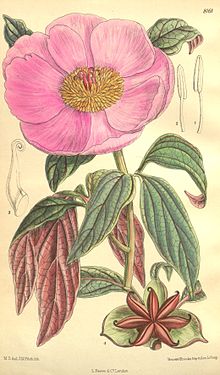Paeonia cambessedesii
| Paeonia cambessedesii | |
|---|---|

| |
| Illustration, Botanical Magazine | |
| Scientific classification | |
| Kingdom: | Plantae |
| Clade: | Tracheophytes |
| Clade: | Angiosperms |
| Clade: | Eudicots |
| Order: | Saxifragales |
| Family: | Paeoniaceae |
| Genus: | Paeonia |
| Species: | P. cambessedesii
|
| Binomial name | |
| Paeonia cambessedesii | |
| Synonyms | |
Paeonia cambessedesii is a
Description
Paeonia cambessedesii is a clump-forming, perennial, herbaceous peony, which dies down in the autumn, and overwinters with
Growth cycle

In February the stalks which have an intense garnet color emerge from the soil. This color is the result of a high concentration of anthocyanins, whose dark color absorbs sunlight and prevents freezing of these young and tender parts early in the year. In March the emerging stem unfolds and leaves and buds become clearly visible. A few weeks later flowering may start. First the stigmas are fertile for a few days, while the anthers remain closed to prevent self-pollination. by the time the ovaries have been fertilized, the anthers mature and pollen can be picked up by insects and carried to other flowers.
In late August, the ripe fruits open and the shiny black seeds can be dispersed. Unfertilised seeds appear as red, soft granules with flat surfaces. The seedlings of this peony usually only appear after several winters. Young plants first appear in early spring and are protected against frost by their high anthocyanin content.[2]
P. cambessedesii differs from all other peonies as its lower leaves have (seven to) nine entire leaflets, never more or incised, all its parts are absolutely hairless, it has on average more carpels per flower than any other Eurasian herbaceous peony: (3-) 4-6 (-8), and it has nearly always reddish purple stems and undersides of the leaves throughout the season. It is most related to
Taxonomy
P. cambessedesii is a diploid (2n=10) species of hybrid origin, and is, like all other Eurasian herbaceous species, assigned to the section Paeonia. One of the parents of P. cambessedesii is
Etymology
The species is named in honor of Jacques Cambessèdes, a French botanist who collected in the Balearic Islands.
Distribution and ecology
Paeonia cambessedesii is an
Conservation

The Balearic peony's territory has shrunk, not only as a result of damage inflicted by grazing animals such as feral goats, but due also to the picking of flowers and the uprooting of wild plants for garden use by humans. Habitat degradation is a further contributing factor, growth sites being damaged or destroyed by urban sprawl, including tourism-related development.[2]
Cultivation
The plant is now regarded as a collectors item for plantsmen's gardens. The plant is probably not very hardy and vulnerable to stagnant water, so may be expected to perform best in temperate climates when offered deep, well-draining, lime-rich soil, in a warm, sunny and well protected location.[3] In cultivation the plant has gained the Royal Horticultural Society's Award of Garden Merit.[7][8]
Germination
It is suggested that seeds can be tricked into early germination by putting them in a closed container under a moist topsoil and storing them in a refrigerator for three or four months. In early spring the seeds can be sown outside and these usually germinate within a few weeks without problems. If the seeds do not germinate after the first cold treatment, it is advised to repeat it until successful. The small seedlings of Paeonia cambessedesii share the intense gamut of color with the shoots of their parents and are protected against frost this way. It may take four or five years before the plant is capable of producing its first flower.[2]
Other uses
The root of the Balearic peony is said to have been used as a cure against epilepsy.[9]
References
- ^ "Paeonia cambessedesii". The Plantlist. Retrieved 17 May 2016.
- ^ a b c d e Juan Bibiloni (3 February 2012). "Dedos de Sangre [Bloodfingers]". Sangrado en Verde (in Spanish). Retrieved 17 May 2016.
- ^ ISBN 978-2-88032-202-1. Retrieved 17 May 2016.
- ^ Hong, De-Yuan (2010). Peonies of the World. London/St. Louis: Kew Publishing/Missouri Botanical Garden. pp. 149–152.
- PMID 7624325.
- ISBN 84-7283-354-2.
- ^ "RHS Plant Selector - Paeonia cambessedesii". Retrieved 16 January 2021.
- ^ "AGM Plants - Ornamental" (PDF). Royal Horticultural Society. July 2017. p. 71. Retrieved 17 April 2018.
- S2CID 171046217.
